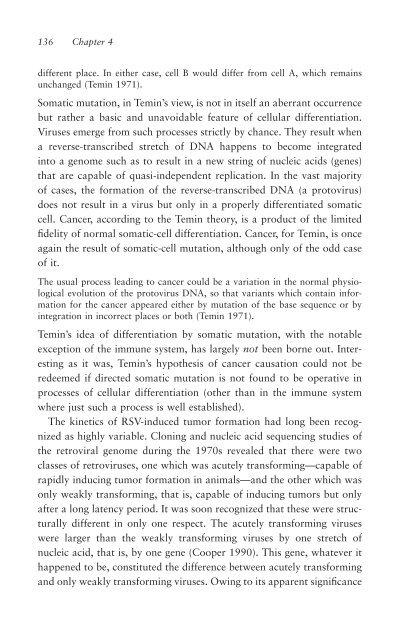A Critique of Pure (Genetic) Information
A Critique of Pure (Genetic) Information
A Critique of Pure (Genetic) Information
You also want an ePaper? Increase the reach of your titles
YUMPU automatically turns print PDFs into web optimized ePapers that Google loves.
136 Chapter 4<br />
different place. In either case, cell B would differ from cell A, which remains<br />
unchanged (Temin 1971).<br />
Somatic mutation, in Temin’s view, is not in itself an aberrant occurrence<br />
but rather a basic and unavoidable feature <strong>of</strong> cellular differentiation.<br />
Viruses emerge from such processes strictly by chance. They result when<br />
a reverse-transcribed stretch <strong>of</strong> DNA happens to become integrated<br />
into a genome such as to result in a new string <strong>of</strong> nucleic acids (genes)<br />
that are capable <strong>of</strong> quasi-independent replication. In the vast majority<br />
<strong>of</strong> cases, the formation <strong>of</strong> the reverse-transcribed DNA (a protovirus)<br />
does not result in a virus but only in a properly differentiated somatic<br />
cell. Cancer, according to the Temin theory, is a product <strong>of</strong> the limited<br />
fidelity <strong>of</strong> normal somatic-cell differentiation. Cancer, for Temin, is once<br />
again the result <strong>of</strong> somatic-cell mutation, although only <strong>of</strong> the odd case<br />
<strong>of</strong> it.<br />
The usual process leading to cancer could be a variation in the normal physiological<br />
evolution <strong>of</strong> the protovirus DNA, so that variants which contain information<br />
for the cancer appeared either by mutation <strong>of</strong> the base sequence or by<br />
integration in incorrect places or both (Temin 1971).<br />
Temin’s idea <strong>of</strong> differentiation by somatic mutation, with the notable<br />
exception <strong>of</strong> the immune system, has largely not been borne out. Interesting<br />
as it was, Temin’s hypothesis <strong>of</strong> cancer causation could not be<br />
redeemed if directed somatic mutation is not found to be operative in<br />
processes <strong>of</strong> cellular differentiation (other than in the immune system<br />
where just such a process is well established).<br />
The kinetics <strong>of</strong> RSV-induced tumor formation had long been recognized<br />
as highly variable. Cloning and nucleic acid sequencing studies <strong>of</strong><br />
the retroviral genome during the 1970s revealed that there were two<br />
classes <strong>of</strong> retroviruses, one which was acutely transforming—capable <strong>of</strong><br />
rapidly inducing tumor formation in animals—and the other which was<br />
only weakly transforming, that is, capable <strong>of</strong> inducing tumors but only<br />
after a long latency period. It was soon recognized that these were structurally<br />
different in only one respect. The acutely transforming viruses<br />
were larger than the weakly transforming viruses by one stretch <strong>of</strong><br />
nucleic acid, that is, by one gene (Cooper 1990). This gene, whatever it<br />
happened to be, constituted the difference between acutely transforming<br />
and only weakly transforming viruses. Owing to its apparent significance
















